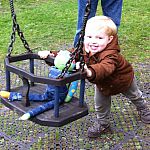 "Work" should be fun!
"Work" should be fun!
Return to our home page. This page was last updated in June 2017, there may be more recent papers here.
Below you can find information about our academic papers on both word learning and categorisation (for papers on learning names for categories see word learning) as well as our paper on the NOUN Database.
Word Learning
Our word learning papers include papers on Storybooks, Referent Selection and Retention and the Shape Bias as well as categorisation.
Word Learning From Storybooks
Axelsson, E. L., Williams, S. E. & Horst, J. S. (2016). The Effect of Sleep on Children’s Word Retention and Generalization, Frontiers in Psychology, 7(1192), 1-9. DOI: 10.3389/fpsyg.2016.01192
Horst, J. S. (2015). Word Learning Via Shared Storybook Reading. In B. Kümmerling-Meibauer, J. Meibauer, K. Nachtigäller & K. Rohlfing (Eds.), Learning from Picturebooks, Perspectives from Child Development & Literacy Studies, New York: Routledge.
Williams, S. E., & Horst, J. S. (2014). Goodnight Book: Sleep Consolidation Improves Word Learning via Storybooks, Frontiers in Developmental Psychology, 5(184), 1-12. Cited By.
Horst, J. S. (2013). Context and Repetition in Word Learning. Frontiers in Developmental Psychology, 4(149), 1-11.
Horst, J. S., Parsons, K. L. & Bryan, N. M. (2011). Get the Story Straight: Context Repetition Promotes Word Learning From Storybooks. Fromtiers in Developmental Psychology, 2(17), 1-11.
Word Learning (Referent Selection and Retention)
Axelsson, E. L., Perry, L. K., Scott, E. J. & Horst, J. S. (2016). Near or Far: The Effect of Spatial Distance and Vocabulary Knowledge on Word Learning. Acta Psychologica. 163, 181-187. DOI: 10.1016/j.actpsy.2015.11.006
Perry, L. K., Axelsson, E. L. & Horst, J. S. (2016). Learning what to remember: vocabulary knowledge and children’s memory for object names and features. Infant and Child Development, 25 (4), 247–258 doi: 10.1002/icd.1933
Twomey, K. E., Morse, A., Cangelosi, A. & Horst, J. S. (2016). Children's referent selection and word learning: insights from a developmental robotic system. Interaction Studies: Social Behaviour and Communication in Biological and Artificial Systems, 17(1), 93–119. doi: 10.1075/is.17.1.05two
Axelsson, E. L., & Horst, J. S. (2014). Contextual Repetition Facilitates Word Learning via Fast Mapping. Acta Psychologica, 152, 95-99. DOI: 10.1016/j.actpsy.2014.08.002
Twomey, K. E., Lush, L., Pearce, R. & Horst, J. S. (2014). Visual Variability Affects Early Verb Learning, British Journal of Developmental Psychology, 32(3), 359-366. DOI: 10.1111/bjdp.12042
Twomey, K. E., Ranson, S. L. & Horst, J. S. (2014). That’s More Like It: Multiple Exemplars Facilitate Word Learning. Infant and Child Development, 23 (2), 105-122. DOI: 10.1002/icd.1824
Axelsson, E. L., & Horst, J. S. (2013). Testing A Word Is Not A Test of Word Learning. Acta Psychologica, 144(2), 264-268. DOI: 10.1016/j.actpsy.2013.07.002
McMurray, B., Horst, J. S. & Samuelson, L. K. (2012). Word learning as the interaction of online referent selection and slow associative learning. Psychological Review. 119 (4), pp. 831-877. DOI: 10.1037/a0029872 Cited By.
Axelsson, E. L., Churchley, K. & Horst, J. S. (2012). The Right Thing at the Right Time: Why Ostensive Naming Facilitates Word Learning. Frontiers in Developmental Psychology, 3 (88), 1-8. DOI: 10.3389/fpsyg.2012.00088
Horst, J. S., Samuelson, L. K., Kucker, S. C. & McMurray, B. (2011). What’s New? Children Prefer Novelty in Referent Selection. Cognition, 118(2) 234-244. DOI: 10.1016/j.cognition.2010. 10.015 Cited By. Replicated by Dysart, Mather & Riggs (2016, JECP).
Horst, J. S., Scott, E. J. & Pollard, J. A. (2010). The Role of Competition in Word Learning Via Referent Selection. Developmental Science, 13(5) 706-713. DOI: 10.1111/j.1467-7687.2009.00926.x Cited By.
Horst, J. S. & Samuelson, L. K. (2008). Fast Mapping But Poor Retention in 24-Month-Old Infants. Infancy, 13(2), 128-157. DOI: 10.1080/15250000701795598 Cited By.
Horst, J. S., McMurray, B. & Samuelson L.K. (2006). Online processing is essential for learning: Understanding fast mapping and word learning in a dynamic connectionist architecture. Proceedings of the Twenty-Eighth Annual Conference of the Cognitive Science Society. Lawrence Erlbaum & Associates. Cited By.
The Shape Bias
Horst, J. S. & Twomey, K. E. (2013). It’s Taking Shape: Shared Object Features Influence Novel Noun Generalizations. Infant and Child Development, 22(1), 24-43.DOI: 10.1002/icd.1768
Samuelson, L. K., Schutte, A. R. & Horst, J. S. (2009). The Dynamic Nature of Knowledge: Insights From a Dynamic Field Model of Children's Novel Noun Generalizations. Cognition, 110(3) 322-345. DOI: 10.1016/j.cognition.2008.10.017
Samuelson, L. K. & Horst, J. S. (2008). Confronting complexity: Insights from the details of behavior over multiple timescales. Developmental Science, 11(2), 209-215. DOI: 10.1111/j.1467-7687.2007.00667.x
Samuelson, L. K., Horst, J. S., Schutte, A. R. & Dobbertin, B. (2008). Rigid Thinking About Deformables. Do Children Sometimes over generalize the Shape Bias? Journal of Child Language, 35,559-589. DOI: 10.1017/S0305000908008672
Samuelson, L. K., & Horst, J. S. (2007). Dynamic noun generalization: Moment-to-moment interactions shape children's naming biases. Infancy, 11(1), 97-110. DOI: 10.1207/s15327078in1101_5
Samuelson, L. K., Horst, J. S., Dobbertin, B. N. & Schutte, A. R. (2006). Knowledge, Performance, and Task: Decalage and Dynamics in Young Children's Noun Generalizations. Proceedings of the Twenty-Eighth Annual Conference of the Cognitive Science Society. Lawrence Erlbaum & Associates.
Categorisation
Horst, J. S. & Simmering, V. R. (2015). Category Learning in a Dynamic World. Frontiers in Psychology, 6 (46). doi: 10.3389/fpsyg.2015.00046
Horst, J. S., Ellis, A. E., Samuelson, L. K., Trejo, E., Worzalla, S., Peltan, J. & Oakes, L. M. (2009). Toddlers Can Adaptively Change How They Categorize: Same Objects, Same Session, Two Different Categorical Distinctions. Developmental Science, 12(1) 96-105.
Oakes, L. M., Kovack-Lesh, K. A., & Horst, J. S., (2009). Two are better than one: Comparison influences infants' visual recognition memory. Journal of Experimental Child Psychology, 104(1) 124-131.
Kovack-Lesh, K.A., Horst, J. S. & Oakes, L.M. (2008) The Cat is Out of the Bag: Previous Experience and Online Comparison Jointly Influence Infant Categorization. Infancy, 13(4) 285-307.
Horst, J. S., Oakes, L. M. & Madole, K. L. (2005). What Does It Look Like and What Can It Do? Category Structure Influences How Infants Categorize. Child Development, 76, 614-631.
NOUN Database
Horst, J. S. & Hout, M. C. (in press). The Novel Object and Unusual Name (NOUN) Database: a collection of novel images for use in experimental research. Behavior Research Methods. Manuscript accepted for publication.
